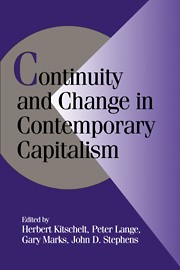Book contents
- Frontmatter
- Contents
- List of Contributors
- Preface
- Introduction
- PART I THE INTERNATIONAL SETTING FOR POLITICAL-ECONOMIC STRATEGIES
- PART II THE DYNAMICS OF DOMESTIC POLITICAL ECONOMIES
- PART III POLITICAL ECONOMY AND DEMOCRATIC COMPETITION
- 10 Politics without Class: Postindustrial Cleavages in Europe and America
- 11 European Social Democracy between Political Economy and Electoral Competition
- 12 Contemporary Christian Democracy and the Demise of the Politics of Mediation
- 13 The Political Economy of Neoliberalism: Britain and the United States in the 1980s
- 14 Movements of the Left, Movements of the Right: Putting the Mobilization of Two New Types of Social Movements into Political Context
- PART IV CONCLUSION
- References
- Index
- Title in the series
14 - Movements of the Left, Movements of the Right: Putting the Mobilization of Two New Types of Social Movements into Political Context
Published online by Cambridge University Press: 05 June 2012
- Frontmatter
- Contents
- List of Contributors
- Preface
- Introduction
- PART I THE INTERNATIONAL SETTING FOR POLITICAL-ECONOMIC STRATEGIES
- PART II THE DYNAMICS OF DOMESTIC POLITICAL ECONOMIES
- PART III POLITICAL ECONOMY AND DEMOCRATIC COMPETITION
- 10 Politics without Class: Postindustrial Cleavages in Europe and America
- 11 European Social Democracy between Political Economy and Electoral Competition
- 12 Contemporary Christian Democracy and the Demise of the Politics of Mediation
- 13 The Political Economy of Neoliberalism: Britain and the United States in the 1980s
- 14 Movements of the Left, Movements of the Right: Putting the Mobilization of Two New Types of Social Movements into Political Context
- PART IV CONCLUSION
- References
- Index
- Title in the series
Summary
The upheaval of the late 1960s constitutes the background for the mobilization of what came to be the most important social movements in western Europe during the 1970s and 1980s: the so-called new social movements. This cluster of social movements includes the ecology movement (with its antinuclear branch), the peace movement, the solidarity movement (solidarity with the Third World), the women's movement, the squatters' (or urban autonomous) movement, as well as various other movements mobilizing for the rights of disadvantaged minorities (such as the gay movement). On the one hand, these movements go back to the new left, the new generation of radicals who were the protagonists of the antiauthoritarian revolt of the late 1960s. On the other hand, they are an offspring of the citizens' action committees that had started to articulate more specific grievances of local or regional populations in the early 1970s. These citizens' action committees were much more pragmatic and at the same time much broader in scope than the new left proper. Thanks to their dual political roots, the new social movements have managed to achieve what the new left has never been able to do on its own – the political mobilization of masses of citizens on behalf of their emancipatory goals.
The new social movements have dominated the social movement sector in many western European countries since the end of the “golden age.” More recently, another type of movement has risen that is associated not with the left but with the radical right.
- Type
- Chapter
- Information
- Continuity and Change in Contemporary Capitalism , pp. 398 - 424Publisher: Cambridge University PressPrint publication year: 1999
- 51
- Cited by



